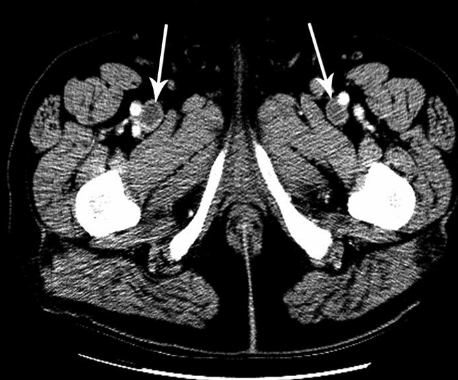Deep venous thrombosis (DVT) is a manifestation of venous thromboembolism (VTE). Although most DVT is occult and resolves spontaneously without complication, death from DVT-associated massive pulmonary embolism (PE) causes as many as 300,000 deaths annually in the United States. See the image below:

Signs and symptoms
Symptoms of deep venous thrombosis (DVT) may include the following:
- Edema - Most specific symptom
- Leg pain - Occurs in 50% of patients but is nonspecific
- Tenderness - Occurs in 75% of patients
- Warmth or erythema of the skin over the area of thrombosis
- Clinical symptoms of pulmonary embolism (PE) as the primary manifestation
As many as 46% with patients with classic symptoms have negative venograms, and as many as 50% of those with image-documented venous thrombosis lack specific symptoms.
No single physical finding or combination of symptoms and signs is sufficiently accurate to establish the diagnosis of DVT, but physical findings in DVT may include the following:
- Calf pain on dorsiflexion of the foot (Homans sign)
- A palpable, indurated, cordlike, tender subcutaneous venous segment
- Variable discoloration of the lower extremity
- Blanched appearance of the leg because of edema (relatively rare)
Potential complications of DVT include the following:
- As many as 40% of patients have silent PE when symptomatic DVT is diagnosed
- Paradoxic emboli (rare)
- Recurrent DVT
- Postthrombotic syndrome (PTS)
Diagnosis
The American Academy of Family Physicians (AAFP)/American College of Physicians (ACP) recommendations for workup of patients with probable DVT are as follows :
- Validated clinical prediction rules (eg, Wells) should be used to estimate the pretest probability of venous thromboembolism (VTE) and interpret test results
- In appropriately selected patients with low pretest probability of DVT or PE, it is reasonable to obtain a high-sensitivity D-dimer
- In patients with intermediate to high pretest probability of lower-extremity DVT, ultrasonography is recommended
- In patients with intermediate or high pretest probability of PE, diagnostic imaging studies (eg, ventilation-perfusion scan, multidetector helical CT, and pulmonary angiography) are required
The main laboratory studies to be considered include the following:
- D-dimer testing
- Coagulation studies (eg, prothrombin time and activated partial thromboplastin time) to evaluate for a hypercoagulable state
Management
Treatment options for DVT include the following:
- Anticoagulation (mainstay of therapy) - Heparins, warfarin, factor Xa inhibitors, and various emerging anticoagulants
- Pharmacologic thrombolysis
- Endovascular and surgical interventions
- Physical measures (eg, elastic compression stockings and ambulation)
Heparin products used in the treatment of DVT include the following:
- Low-molecular-weight heparin (LMWH; eg, enoxaparin)
- Unfractionated heparin (UFH)
Factor Xa inhibitors used in the treatment of DVT include the following:
- Fondaparinux – This agent appears to be comparable to enoxaparin with respect to efficacy and safety
- Rivaroxaban – This agent appears to prevent VTE recurrence as effectively as enoxaparin followed by a vitamin K antagonist and may be associated with less bleeding ; in addition, it appears to be usable in high-risk groups
Endovascular therapy is performed to reduce the severity and duration of lower-extremity symptoms, prevent PE, diminish the risk of recurrent VTE, and prevent PTS. Percutaneous transcatheter treatment of DVT includes the following:
- Thrombus removal with catheter-directed thrombolysis – American College of Chest Physicians (ACCP) recommends thrombolytic therapy only for patients with massive iliofemoral vein thrombosis associated with limb ischemia or vascular compromise
- Mechanical thrombectomy
- Angioplasty
- Stenting of venous obstructions
American Heart Association (AHA) recommendations for inferior vena cava filters include the following:
- Confirmed acute proximal DVT or acute PE in patients contraindicated for anticoagulation
- Recurrent thromboembolism while on anticoagulation
- Active bleeding complications requiring termination of anticoagulation therapy

